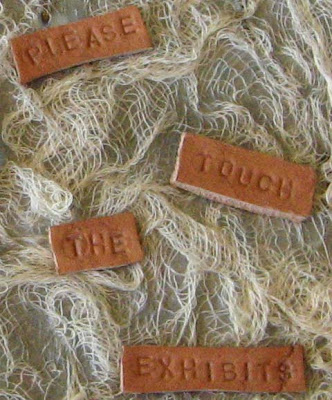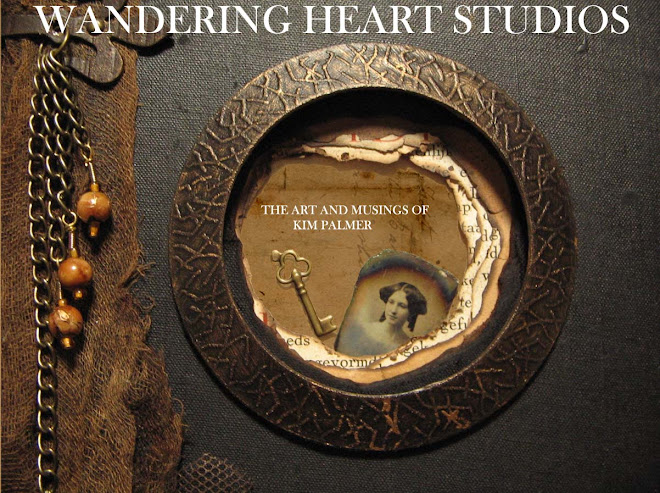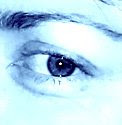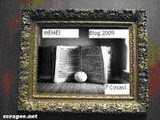I don't say this every day but...

YOU CAN TOUCH!!!
I knew you would be so excited!
Now I last left you deep in the labyrinth. If you were left a little anxious after the last post about what was going to come next...
well now you can relax!
The second section of my contribution to Lisa's book revolves around nature, how we as artists are wont to reproduce it and the beauty it provides us with. It seems since man first stuck his finger in the mud and painted on a cave wall, artists have constantly reinvented, recreated and reproduced the natural world in their artwork. Nature has apparently got the goods when it comes to creative inspiration. So how does that translate into the labyrinth theme of Lisa's book?
When I was thinking about this idea I started to notice the myriad things we are surrounded with every day and how labrynthine the structures of some of these items are. I was gazing at probably the most awful plastic placemat in history in a cheapy store when suddenly it occured to me how much the plastic reminded me of vines or ivy climbing up a wall. Said revolting placemat suddenly wasn't such a bad evil item and promptly came home with me for the grand sum of 20cents AUS, and into the book it went. Some creative chopping here and there, a little copper and voila!

The page is a reflection on mans constant reproduction of nature in art. How we take the forms we find around us and find new ways with available materials to reproduce those forms. The found poetry from the underlying page reads:
Then inspiration came,
too wild this burst of sentiment interrupted true reason?
I think creative ideas are frequently like this. A sudden burst overtakes us and for good or bad out it flows until it's finished. Sometimes the ideas and execution are great, at other times...
well no-one is perfect everyday!
The next page also reflects man's continued drive to represent the labyrinthine form in art, but has taken a somewhat 90 dgree turn in thinking. The page is a representation of celtic knotwork. Celtic knotwork sprang into being around the 8th century AD. It is supposed that originally the forms were created to represent particular significance, but unfortunately the knowledge no longer exists and art historians can come to no consensus on the matter. What is agreed upon in general is that the interlacing patterns represent the unending continuum of life. The crossing and recrossing of the plaits is symbolic of the ongoing connection between the physical and spiritual planes. The three lobed Triquetra (the design used below is a derivative of this form), symbolises the connection between the three planes of existance, mind body and spirit.

YOU CAN TOUCH!!!
I knew you would be so excited!
Now I last left you deep in the labyrinth. If you were left a little anxious after the last post about what was going to come next...
well now you can relax!
The second section of my contribution to Lisa's book revolves around nature, how we as artists are wont to reproduce it and the beauty it provides us with. It seems since man first stuck his finger in the mud and painted on a cave wall, artists have constantly reinvented, recreated and reproduced the natural world in their artwork. Nature has apparently got the goods when it comes to creative inspiration. So how does that translate into the labyrinth theme of Lisa's book?
When I was thinking about this idea I started to notice the myriad things we are surrounded with every day and how labrynthine the structures of some of these items are. I was gazing at probably the most awful plastic placemat in history in a cheapy store when suddenly it occured to me how much the plastic reminded me of vines or ivy climbing up a wall. Said revolting placemat suddenly wasn't such a bad evil item and promptly came home with me for the grand sum of 20cents AUS, and into the book it went. Some creative chopping here and there, a little copper and voila!

The page is a reflection on mans constant reproduction of nature in art. How we take the forms we find around us and find new ways with available materials to reproduce those forms. The found poetry from the underlying page reads:
Then inspiration came,
too wild this burst of sentiment interrupted true reason?
I think creative ideas are frequently like this. A sudden burst overtakes us and for good or bad out it flows until it's finished. Sometimes the ideas and execution are great, at other times...
well no-one is perfect everyday!
The next page also reflects man's continued drive to represent the labyrinthine form in art, but has taken a somewhat 90 dgree turn in thinking. The page is a representation of celtic knotwork. Celtic knotwork sprang into being around the 8th century AD. It is supposed that originally the forms were created to represent particular significance, but unfortunately the knowledge no longer exists and art historians can come to no consensus on the matter. What is agreed upon in general is that the interlacing patterns represent the unending continuum of life. The crossing and recrossing of the plaits is symbolic of the ongoing connection between the physical and spiritual planes. The three lobed Triquetra (the design used below is a derivative of this form), symbolises the connection between the three planes of existance, mind body and spirit.

The page was designed to look like old crumbling plasterwork. Why, just because I wanted to, OKAY! :)
(I like old plasterwork, and I wanted to see if I could!)
Here's the double page spread as it appears in the book.

So having looked at man's continued drive to represent nature in his art, that leads us back to the inspirational forms found in nature itself.
Over the page we go and...

Nature produced the original labyrinths for us as inspiration and we have been reproducing them ever since.
The intricasies of a leaf that reveals its innner skeletal structure as it decomposes. A flower from my garden.
On the other side of the page...
something a little different.

As some of you know, I'm fond of doors in my art.
Couldn't resist this opportunity could I?


Nature produced the original labyrinths for us as inspiration and we have been reproducing them ever since.
The intricasies of a leaf that reveals its innner skeletal structure as it decomposes. A flower from my garden.
On the other side of the page...
something a little different.

As some of you know, I'm fond of doors in my art.
Couldn't resist this opportunity could I?

(Apologies to Lisa, the book will never close again!)
Under the door the cabinet contains...
some of natures best efforts!

The page contains some exhibits including, coral, bees wax, a shell fragment and an insect wing.
What better examples of natures labyrinths could I find!
(Okay, ones that will fit in the book people!)
The pages have been cast in resin then attached to the book. When I first pondered the idea of natural labyrinths and their inclusion in the book I couldn't work out how I was going to be able to post the book successfully across the world. It has to travel constantly between the States, Australia and New Zealand. This constituted a customs nightmare trying to include these items in an altered book until I hit upon the idea of casting the pages in resin. Hopefully Mr. Customs man will have no objections now and the book can travel safely through everyone's hands!
So now you can touch!

The page as it appears fully opened.

The pieces although encased in resin still reveal their structure if you touch them. You can still feel the the items under the resin.
I have created a small magnifier that detaches from the page to help one examine the exhibits in the cabinet.

The page as it appears fully opened.

The pieces although encased in resin still reveal their structure if you touch them. You can still feel the the items under the resin.
I have created a small magnifier that detaches from the page to help one examine the exhibits in the cabinet.

And so to the end of my contribution to Lisa's book. I have had so much fun with this theme and enjoyed finding solutions to obstacles that came with the ideas I wanted to include here. I can't wait for the next book to fly it's way over the waters to me. It will be Lisa Jurists gorgeous book and I am so looking forward to seeing and touching the already gorgeous work that Lisa and Lisa (NO it's not a mistake Lisa J posted to Lisa S!) have put into it!

































15 comments:
If it is at all possible to die of happiness 2 x in one night then I have just done it. If not it's a miracle! This really is wonderful (as I just manages to say on the pulp blog!) all of it, the cheap tacky placemat re-invented, the poem, the knot but most especially the nature bits! I was wondering how you got around the customs thing till I saw the resin. Maybe we should include pens in our boxes just incase? lol. that way the customs people can atleast leave a comment! haha. You're too clever! Thankyou Kim!
Just saw your comment on my blog...yes I know that red thingee will belong to something lol. Just so long what ever it was still works without that there I am sure I can improvise! lol. Thankyou for yoru lovely comment. I shall be having happy dreams tonight!
still giggling over Lisa's comment on the red thingy! how often have I done that!! you really got it spot on Kim! love the resin and the brilliant way you out foxed the post on that! the cheesecloth is gorgeous texture as well as the vines and the Celtic knot!! love always how you weave the information and history into your work making it twice as chewy in texture and desirability! you rock!!!xoxo
This is so creative and unique Kim.. I was wondering what the placemat was when i saw your pulp post.. now it all comes together! Fantastic theme and history.. just love the way you designed it all to intermingle with your art! did you use ICE resin? What a brilliant way to use flora and fauna in collages. I'm so anxious to see your magnificent work in person!
KIm, this sums it all up very well! Everything makes complete sense and once again you've just drawn me right in with all your research and history! Marvellous stuff. Like I said on the Pulpy page the Celtic knotwork is my favourite - very spiritual and yet, natural. The details are magnificent too - eso teh magnifying glass. I love looking at things more closely like that. The ireal beauty is in the detail!!! Love it!!!!!
Well Kim, you are over the top once again with this fantastic post. It is mesmerizing to wander with you through your studied observations which you then put to art. The double spread page is wonderful, both sides mirroring the mazy curvy wandering way of nature. I love all of the materials you chose. Very touchable indeed!
What truly gorgeous pages of nature and design. Just love all of the creative organization, the design and seeing your nature specimens in resin. Your celtic design is wonderful, but even more amazing is your creative artwork- so successful and beautiful in every sense of the word. Thanks for such a wonderful showcasing of these pages!!
Too beautiful and too clever for words. Wonderful work.
To touch must be pure delight, seeing certainly is an absolute pleasure ... hard to find words to express ... thank you so much for sharing these breathtaking and inspiring pages ... your words always inspire as well Kim !!!
I see I am not the only one that collects cicada wings ;)
oxo
Wow, Kim, this is an incredible post... your pages so textural and beautiful, I wish I could touch them! And you even included a magnifying glass. I love the touches of nature that you used and the Celtic knot... roxanne
I'm blown away! Absolutely divine!
Hi Kim, nothing left to say for me, so many treasures to discover!!! I'm just overwhelmed!
Gorgeous and so original! Where do you get these ideas???
Amazing pages. I love your use of the resin. And the plasterworks page is masterful!
Awesome book, Kim! I love every single page, every single detail. Hugs, Svetlana
A magnificent 'beyond words'. Your ideas are fabulous. I'm so impressed.
-Removalists Australia
Post a Comment